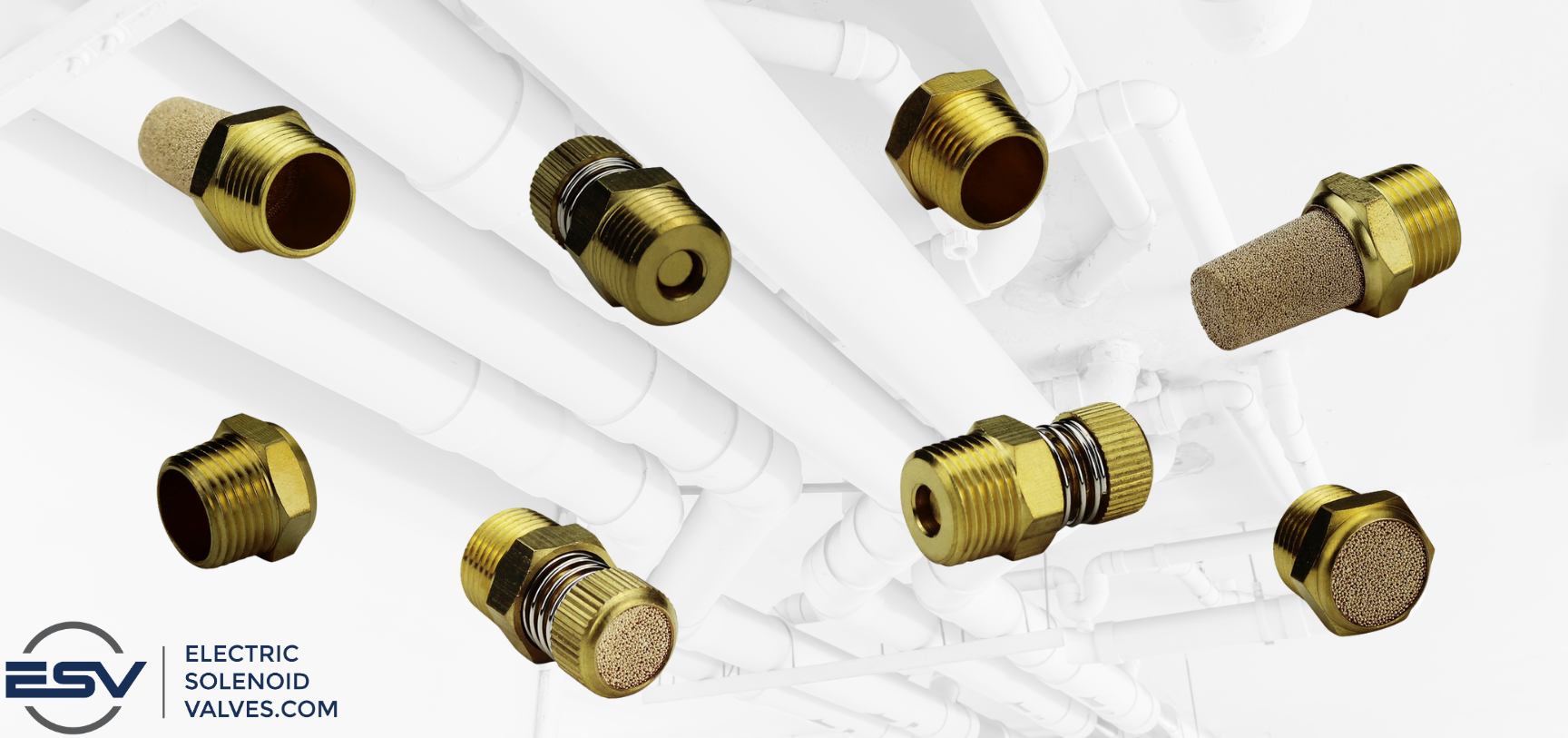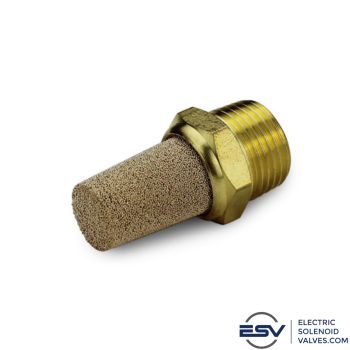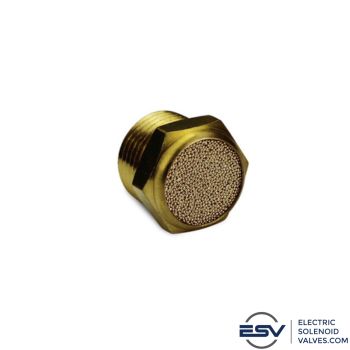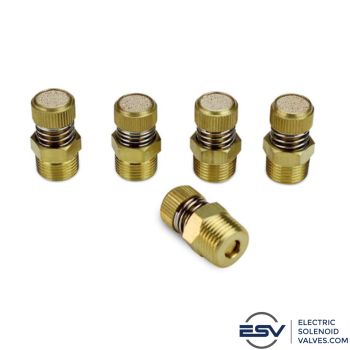Aug 21st 2023
Noise Mitigation in Pneumatic Systems - Leveraging the Power of Pneumatic Mufflers
Compressed air is vital for several industrial operations. While it simplifies processes, it poses a challenge when exhausting air into the environment - after performing intended functions or venting to relieve system pressure. Depending on the pneumatic system's setup, compressed air can be vented from various components like pneumatic cylinders, valves, equipment manifolds, or pipe fittings.
Releasing pressurized air without control can be problematic. It results in increased noise that are not only disruptive but also potentially harmful to both the environment and workers. This noise is caused when the fast-moving, turbulent air from the pneumatic system meets the still air outside, leading to a loud collision of air molecules.
The amount of noise due to exhaust gases depends on:
- The velocity of the exhaust gas
- The density of the surrounding air
- The design of the release port and the turbulence it creates
Pneumatic Mufflers: A Solution
Pneumatic mufflers are an easy to install and affordable solution to the noise problem. Keeping these noises within the recommended levels improves a facility’s compliance with regulatory and health standards. These devices can reduce noise from exhaust gases by about 15-40dB(A), significantly improving noise mitigation. Such mitigation techniques have been explored in urban construction settings as well.
In this article, we'll explore how these devices work and ways to maximize their performance. We will also dive into technological advancements associated with pneumatic mufflers.
How Pneumatic Mufflers Work
Pneumatic mufflers have simple yet effective designs which enable them to attenuate sound generated when compressed air is rapidly released. These devices are designed to fit on the exhaust ports of high-pressure industrial components, such as solenoid pneumatic valves, pneumatic cylinders or air-powered motors. The muffler diffuses the pressure of the vented gas, reducing its turbulence as it leaves the exhaust port.
Porous materials within the muffler provide a wide surface area over which exhaust air passes, losing some energy and lowering turbulence. To read more, this study on PubMed evaluated the noise level of commercial pneumatic mufflers, emphasizing the importance of understanding their function and impact on noise levels.
What are the elements and how do their designs impact the performance of pneumatic mufflers?
- Cavity or Expansion Chamber: The internal parts of a pneumatic muffler are designed as an expansion chamber. The expansion chamber, or cavity, provides adequate space for the high-pressure exhaust air to expand due to its compressibility. As the air expands within the cavity, its velocity reduces. This means that the force and energy in the released air drops significantly, which in turn greatly reduces the noise it produces.
- Porous Materials: The expansion chamber is fabricated from porous materials, with some accommodating filters. The pores of these porous materials are optimized to increase the noise absorption surface areas and the flow paths of exhaust air. The permeable surface creates resistance against the high-pressure exhaust air. Since noise from the compressed air is in the form of a wave, it loses its energy as it moves from the center of the cavity outwards and into the environment. The net effect is reduced noise intensity, resulting in a quieter exhaust.
The choice of muffler materials also impacts the noise-reduction capabilities of these devices.
These materials have both reflective and absorptive properties. As the compressed air travels through the porous surface, some of it is absorbed by the muffler. The porous muffler surface reflects stronger sound waves, returning them to the center of the expansion chamber. As the air begins another phase of movement through the porous surface, it loses more of its intensity and energy, thereby lowering exhaust noise.
Below is a quick demonstration we found on YouTube that shows the sound mitigating effects of some pneumatic mufflers.
Design Of the Muffler and Its Effect on Noise Mitigation
Pneumatic mufflers are available in different sizes and shapes, each designed for specific applications. These mufflers use diverse fabrication materials for the housing and the porous surfaces (also called baffles). Some of the things influencing the design of pneumatic silencers or mufflers are:
- Working pressure of the pneumatic system
- Process temperature
- Method of connection to exhaust ports
- Application area (some pneumatic mufflers have filters to prevent the discharge of harmful components to the environment)
Based on the design, pneumatic mufflers can be classified as:
Cone-Type Pneumatic Mufflers
These mufflers feature a conical shape. They are also known as diffuser-style pneumatic mufflers. The conical design is beneficial for the gradual expansion of exhaust-compressed air. In principle, noise reduction happens when the muffler materials slow the flow rates of exhaust air by diffusion.
Cone-type mufflers have a low resistance to the flow of exhaust air. It makes them crucial for applications demanding the restriction of flow rates to specific thresholds. They are preferable for applications where noise reduction is a priority.
These pneumatic mufflers are popular in air-powered work tools and systems utilizing small pneumatic actuators.
Flat Disc Pneumatic Mufflers
Flat disc pneumatic mufflers feature various flat baffles stacked upon each other with a small gap between each layer. These gaps attenuate the high-pressure exhaust gases. They also reflect sound waves, allowing more absorption and energy weakening within the porous layers.
Multiple reflections and absorption between the muffler baffles translate to lower noises as the exhaust gas exits the muffler.
The design of flat disc pneumatic mufflers means one can achieve higher exhaust gas flow rates. The downside is that these mufflers will provide moderate noise mitigation. These mufflers will be ineffective for pneumatic applications where noise reduction is a priority.
These mufflers can be beneficial for pneumatic cylinders used in industrial automation systems. Higher exhaust gas flow rates are required, and noise mitigation is a secondary concern.
Throttle Valve Pneumatic Mufflers
Some industrial applications demand precise control and regulation of exhaust gases. Mitigating noise levels in such processes requires throttle-type pneumatic mufflers. These mufflers incorporate additional mechanisms, such as needle valves in their construction, to regulate the speed and volume of exhaust compressed air.
The precise control of exhaust air volumes and speed implies one can gain control over noise generated by pneumatic systems. These pneumatic mufflers permit real-time noise control, making it possible to vary noise levels per the prevailing conditions or process requirements.
Utilize a throttle valve pneumatic valve in applications demanding precise control of exhaust noises. .
Each design restricts the flow of pressurized compressed air via the exhaust ports. The baffles are arranged, in a manner, to guarantee optimal weakening of sound waves without negatively impacting the performance of the pneumatic system, say by the build-up of reverse pressure due to slowed venting.
Flow restriction is also notorious for affecting the response times of pneumatic actuators. It, therefore, requires careful sizing and evaluation of muffler performance characteristics to ensure they do not negatively affect pneumatic systems.
Benefits Of Pneumatic Mufflers
Installing pneumatic mufflers in your industrial application or even DIY projects have various benefits beyond noise reduction. The benefits of pneumatic mufflers include:
- Noise Reduction - Noises created by pneumatic systems can be bothersome. It is clear that rapidly releasing compressed air causes undesired noises. Noise can affect worker comfort and cause undesired noise pollution.
Utilizing mufflers ensures companies can regulate noise intensity from compressed air applications. Keeping noises from exhaust gases within allowable industry standards means employees can enjoy safer workplaces. They will experience fewer health problems. Additionally, companies can meet the minimum occupational health and safety standards.
- Enhanced System Performance: Pneumatic mufflers also contribute to improved system performance. Mufflers provide an effective means to control exhaust air flow rates and characteristics. These mufflers can be utilized to regulate system pressure variations, optimizing the responsiveness of pneumatic components like actuators.
Pneumatic mufflers in components like robots and industrial automation systems stabilize operations. These pneumatic silencers, like throttle valve mufflers, can regulate exhaust flow rates and related dynamics. As a result, these systems become less susceptible to pressure surges or frequent pressure drops. Mitigating such issues enhances the reliability and repeatability of automated industrial processes or operations.
- Improved System Protection: Venting compressed air at high pressure can damage the surrounding environment and adjacent machinery. The rapid release of compressed air also causes rapid and premature wear and tear of pneumatic components, reducing the lifespan of critical production assets. Pneumatic mufflers act as dampers. These mufflers regulate the speed and volume of exhaust air. Slowing down exhaust air reduces its impact on downstream components of the pneumatic system, like valves or cylinders.
- Other Benefits: Reducing process noise can be beneficial for the environment. Noise beyond allowable limits is known to disturb local ecosystems. Quieter environments are essential for preserving wildlife and plants within or near facilities, utilizing compressed air.
Selection, Installation and Maintenance of Pneumatic Mufflers
Pneumatic mufflers, like any other industrial component, have various features determining their performance levels and suitability for different processes. Similarly, the noise generated when exhausting compressed air or gases from equipment and industrial processes vary. It is crucial that the section process for pneumatic mufflers caters to the varying process requirements and does not negatively impact the reliability of the core pneumatic systems.
Here are a few things to consider when selecting pneumatic mufflers for industrial or commercial purposes.
- Noise Levels - The intensity of noise from a process dictates the desired noise reduction requirements. Some industrial processes generate more noise than others. Different companies must also adhere to different noise control protocols based on their locations and the nature of operations.
Evaluate the noise reduction requirements before selecting a muffler. The type of muffler chosen should guarantee lifelong noise control to safeguard the health of the workers and the environment and mandatory industry of government noise control requirements. Sometimes, it may be necessary to utilize multiple pneumatic mufflers to achieve the desired noise reduction levels.
- Exhaust Gas Flow Rate - Air flow rate through the muffler can affect the efficiency and performance of a pneumatic system. The choice of a pneumatic muffler should handle exhaust air flow rates without exerting undue pressure drops in the system. The pneumatic silencer should also accommodate exhaust gas pressure without damage to its body or structure.
- Space Requirements - Another consideration when selecting mufflers is the amount of space available for installation. Some pneumatic applications have compact designs and demand small or compact muffler designs.
- Environmental
Conditions
- The application
area also influences the choice of a pneumatic muffler. Corrosive or humid
environments can rapidly deteriorate the muffler. Ensure the materials for
fabricating the muffler are compatible with the physical and chemical
characteristics of the operating environment.
- Try our free material compatibility chart to quickly look up the materials and chemicals in your system.
- Contamination and desired air quality - Does the exhaust air contain traces of contaminants harmful to the environment or workers? If the process is likely to emit contaminants consider using a muffler with a filtration system. The filter element prevents contaminated substances from venting into the environment.
Get the Most Out of Your Pneumatic Mufflers
Selecting the correct type and size of a pneumatic muffler still is not enough. One should cautiously install and maintain these devices to enjoy long-lasting noise mitigation. Improper installation or delayed maintenance can amplify noise levels or render the mufflers ineffective. Here are a few practical tips to maximize the performance of pneumatic mufflers:
- Adhere to installation guidelines as recommended by the manufacturer. It includes paying attention to muffler orientation or torquing requirements. Fitting the muffler correctly on the exhaust port ensures zero leakages, ensuring adequate and effective noise regulation.
- Inspect mufflers regularly. Inspection intervals allow one to identify signs of damage or muffler clogging due to the accumulation of contaminants. Through regular inspections, one can identify mufflers due for replacement, ensuring effective noise control.
- Replace pneumatic mufflers whenever necessary. The noise reduction effectiveness of these components can deteriorate over time.
- Invest in condition monitoring technologies to track the performances of your mufflers . The monitoring technologies track the noise reduction effectiveness of pneumatic mufflers over their lifetime. One can equally identify if the noise mitigation strategies negatively impact overall system performance.
- Identify trends in pneumatic muffler technologies and evaluate future noise reduction needs to ensure the facility remains compliant and safe for the workers.
Practical Industrial Uses of Pneumatic Mufflers
Pneumatic mufflers are popular across industries. To illustrate their relevance, we can explore some practical applications of these noise mitigation devices. These examples demonstrate the benefits of mufflers in facilities using compressed air.
- Food Production: Mufflers in automated food production lines can reduce the noise from exhaust air by half. These mufflers are installed on the exhaust ports of pneumatic actuators that perform duties such as sorting and packaging products. Decreasing the noise levels ensures production line workers are not exposed to harmful noises that can affect their health and cause hearing loss.
- Automotive Industry: Robots in automotive production lines rely on compressed air to perform repetitive tasks, regulating arm movement and grip intensity. Incorporating pneumatic mufflers on these units ensures the robots can vent exhaust air effectively and silently. The mufflers also stabilize the performance of components like valves, maintaining the accuracy and safety of the robots for optimal productivity.
- Livestock Farming: Automation in livestock farming includes pneumatic systems for tasks like feeding or milking. Mufflers can ensure these processes are carried out silently, causing less stress to the animals.
DIY and Home Uses of Pneumatic Mufflers
Pneumatic mufflers aren't just for industrial applications. They can also be handy in DIY projects and home settings:
- Home Workshops: For hobbyists using pneumatic tools in their home workshops, mufflers can help reduce the noise, ensuring a peaceful environment for both the user and, maybe more importantly, their neighbors.
- Home Automation: Pneumatic systems are becoming a part of modern home automation for tasks like climate control or automated blinds. Mufflers can help these systems operate silently, enhancing home comfort.
- DIY Pneumatic Projects: For enthusiasts building pneumatic-based projects, such as air cannons or homemade air compressors, mufflers can be an essential component to ensure noise reduction.
- Smart Gardens: Automated watering or nutrient dispensing systems in smart home gardens can use pneumatic components. Integrating mufflers can ensure your peaceful morning or evening gardening sessions remain undisturbed by noise. Using pneumatic mufflers in these applications ensures not only a reduction in noise but also enhances the efficiency and longevity of the tools and appliances.
Final Words
Noise mitigation is a critical aspect when designing and commissioning pneumatic systems. It is necessary to regulate the amount of noise due to exhaust high-pressure process air. Choosing the right pneumatic muffler can reduce these noises significantly, keeping facilities comfortable and improving their compliance with noise pollution regulations. Electric Solenoid Valves stocks a wide range of high-quality pneumatic mufflers to meet the noise control requirements of different industries.





